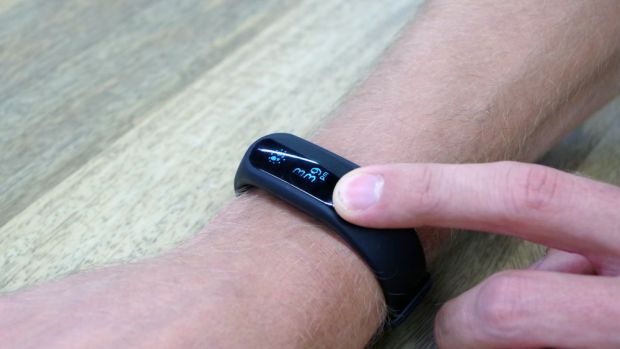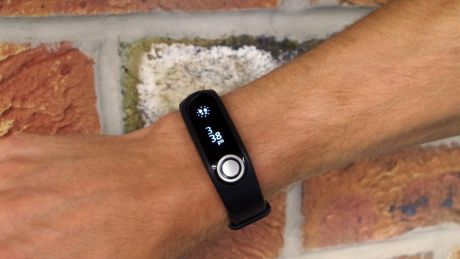Our Verdict
Things we like The ability to measure body composition is a unique and valuable feature for a wrist wearable A weekly step target is a smart addition, providing the motivation to make up for less active days The built-in heart rate monitor is a rare find in an everyday fitness tracker under £100, and the resting heart rate measurement is a useful measure Things we didn’t like While heart rate monitoring is welcome the data for individual activities seemed a bit all over the place, even compared with other fitness trackers in the same bracket, and the data doesn’t load fast enough on the Touch’s screen to be useful during exercise Not enough is made of the Touch’s screen – you have to open the app to see key data Short battery life There’s a lack of detail on activities
You can trust Coach
£99.99, buy on tomtom.com, check price on amazon.co.uk
RECOMMENDED: The Best Fitness Trackers
TomTom Touch In-Depth
Using The TomTom Touch For Step Counting
Your daily step tally is one swipe away from the home screen on the Touch, and when you sync to the TomTom Sports app you also see how close you are to hitting an overall weekly step target. If you miss out on your 10,000 target one day, you can make it up the next to reach 70,000 for the week overall. Hit your daily target and the Touch will buzz at you and show a star. Because that’s what you are. A star.
Using The TomTom Touch As A Heart Rate Monitor
The Touch has a built-in heart rate monitor and takes readings throughout the day to provide a resting heart rate and show how it changes over time in the app. This is a handy measure of your overall fitness.
You can see your heart rate at any time by swiping up from the home screen, but it takes a little while to load and so isn’t really something you can check while exercising unless you’re taking a break.
After you sync any activity to the app, you get a graph showing your heart rate throughout and the time spent in each heart rate zone.
I’m not entirely convinced by the accuracy of the Touch’s heart rate monitor. While the overall average would only be between three and five beats out from the chest strap I tested it against, each activity’s graph showed bizarre peaks and troughs that were plainly wrong.
On one run it logged that I spent the first ten minutes in my max heart rate zone before dropping down to a more consistent level. On another the heart rate fell off a cliff for the final five minutes at the end of the run, when I’d actually picked up the pace. On both occasions this didn’t match up with either how I felt or the recording from the chest strap.
While the accuracy of wrist-based optical heart rate monitors will never be able to match a chest strap by design, and there’s always the possibility that the user isn’t wearing it correctly, we haven’t seen these problems with other fitness trackers.
RECOMMENDED: The Best Heart Rate Monitors
Using The TomTom Touch To Track Activity
For anything more active than step counting you need to tell the Touch you’re undertaking an activity – nothing is automatically tracked – but this is easily done by swiping up on the home screen and touching the silver button on the tracker. Then you touch it again once you’re finished.
While training you can see the duration of your activity, along with the calories burned and your heart rate (if you’re prepared to wait for the latter to load). Once it’s finished you can sync it to the app for more detail and to tag it as whatever you were doing – running, cycling etc.
However, there’s not a great deal of point to that because all activities are given the same five categories of data: calories, average heart rate (plus graph), steps, stride rate and total time. Steps and stride rate are always there, even if you tag it as a cycle, which just seems sloppy.
Using The TomTom Touch For Tracking Body Composition

Let’s talk about the most exciting feature on the Touch – body composition stats. Put your finger on the silver button and the Touch takes a reading, a process that takes about ten seconds… and fails about 40% of the time, in my experience.
That reading is sent to the app next time you sync – you can’t view it on the Touch itself, which is annoying. The reading is a breakdown of your body fat and muscle, which is plotted on a graph in the app so you can hopefully see the fat drop and muscle rise over time.
Body composition is a very useful stat that has previously only really been offered on smart scales. It’s better than a simple weight reading alone because you might find you’re not getting lighter even as you get fitter if you’re packing on a lot of muscle, which can be de-motivating.
There will always be questions of accuracy surrounding body composition stats from consumer devices, but as long as they are consistent and can be used to show your own progress, that’s good enough in my opinion. The Touch’s readings did seem solid enough in that regard.
It’s great that the Touch has added this feature to the wrist wearable world, but it could have been better implemented. The regular failures when you try to take a reading are irritating, and it seems bizarre that you have to go to the app to see the results when it’s just two numbers that could easily fit on the Touch’s screen.
Using The TomTom Touch For Running
There’s no GPS in the Touch or even assisted GPS – you’ll need to venture into higher price brackets for those features – so the run stats you get are the same as any other activity. At least with running the stride rate and steps total are relevant. You don’t get distance stats so in reality the only interesting data you get from a run are the heart rate graph and the overall calories burned.
RECOMMENDED: The Best Running Watches
Using The TomTom Touch For Cycling
As with running, calories burned and heart rate are the only useful stats gained from the Touch. If you’re even a semi-serious runner or cyclist, this isn’t the tracker for you.
Using The TomTom Touch For Swimming
Although the Touch will stand up to a quick shower or a run in the rain, it’s not waterproof enough to take into the pool. At this price we wouldn’t expect it to be.
RECOMMENDED: The Best Swimming Watches
Using The TomTom Touch For Calorie Counting
You can see your overall calories burned tally for the day on your wrist easily. This includes the energy used during your normal life and the active calories burned during exercise. Your calorie count is also on the app homepage, along with your total time active on any given day.
Using The TomTom Touch As A Sleep Tracker
The slim design of the Touch means it’s comfortable to wear at all times, which is always a major plus for sleep tracking. However, TomTom’s sleep tracking is very basic. You just get the total time asleep, which is a measure of how still you are in the evening and overnight.
That means if you settle down to watch a TV show or film and don’t move much, it’ll record you as sleeping, so your overall snooze tallies are likely to be far higher than the actual amount of time you slept.
This puts the Touch a long way behind most trackers which can break down sleep into different periods , while Fitbit’s Sleep Insights (available across the range, including on the Flex 2 which is cheaper than the Touch) are out of sight.
RECOMMENDED: The Best Sleep Trackers
The TomTom Sports App
TomTom’s app does a decent job of presenting the data gleaned from the Touch in a clear and accessible manner, but it doesn’t do anything beyond that, such as incorporating your step counts into bigger challenges – something that is offered by rivals.
Also, given that the app is the only place you can see the battery life of the Touch, it would be good if that was put on the homepage, rather than tucked away in the Manage tab.
The TomTom App will also connect to other fitness apps you might use. Most pertinently for the Touch given its limitations in tracking activity, it links up with calorie counting app MyFitnessPal.
How Often Am I Going To Have To Charge It?
This isn’t good. For starters I found the Touch only lasted three to four days on a full charge, which considering its limited features and small monochrome screen, isn’t great. However, that could be forgiven a little if you could actually see how much battery life is left easily, but you can’t. You have to load the app and then go to the Manage section.
Hopefully TomTom will release an update that shows the battery life on the Touch itself, but if it does, you’ll have to plug the Touch into your computer to update it, unlike most other wearables which can be updated over the air.
Where Can I Wear It Without People Laughing At Me?
The Touch has an slim, understated design and can be worn anywhere comfortably. The strap is interchangeable and TomTom offers a limited range of colours (coral red, indigo purple, azure blue; £19.99 each) so you can mix it up should you so desire.
Should I Consider Something Else?
The unique appeal of the Touch is its ability to provide basic body composition stats, so if you’re really keen on the idea of that, it’s your best bet in a wrist wearable. Although this is available in other ways, such as smart scales.
There is a cheaper version of the Touch without this function available but I’d steer well clear of that. Why? Because all the normal fitness tracking functions on the Touch are done better elsewhere, most notably in the Fitbit Aria HR, Fitbit Charge 2 or Garmin Vivosmart HR. Those are slightly more pricy than the Touch now that TomTom has dropped its price below £100 (it was originally £129.99), but it’s worth a little more for the better functionality and battery life.
You could even spend £20 more and get the most basic version of the excellent TomTom Spark 3. There’s nothing majorly wrong with the TomTom Touch, but it seems a bit underdone and the minor annoyances with it all add up.
RECOMMENDED: The Best Fitness Trackers

Nick Harris-Fry is a journalist who has been covering health and fitness since 2015. Nick is an avid runner, covering 70-110km a week, which gives him ample opportunity to test a wide range of running shoes and running gear. He is also the chief tester for fitness trackers and running watches, treadmills and exercise bikes, and workout headphones.

